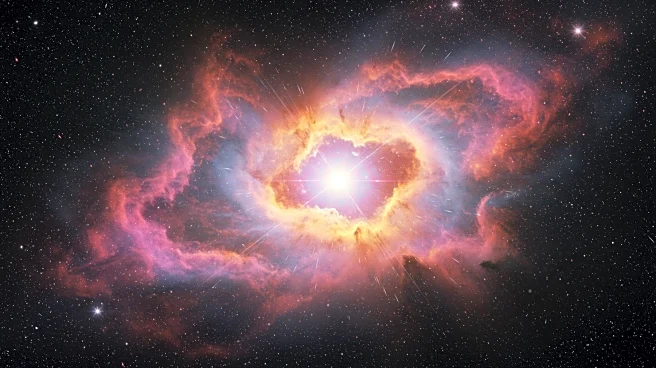What's Happening?
A team of Japanese astronomers has discovered a star-triggered explosion that is shaping its surrounding dusty disk, revealing a chaotic and intense environment. The event was identified by researchers led by Masataka Aizawa from Ibaraki University, using archival data from the ALMA telescope in Chile. They observed an expanding bubble of gas near WSB 52, a young star located 440 light-years away in the constellation Ophiuchus. This bubble is expanding outward and crashing into the protoplanetary disk around the star. The explosion was likely caused by a high-speed jet from the star colliding with a nearby clump of cold gas, compressing it until it exploded. This phenomenon, termed jet-bubble-disk interaction, was not predicted theoretically and suggests that such explosive events may be common in young star systems.
Why It's Important?
The discovery of this star-triggered explosion has significant implications for our understanding of planet formation and the environments in which they develop. If such explosive events are common, newborn stars and their planets may exist in far more chaotic and intense conditions than previously thought. This could affect the formation and characteristics of planets, potentially leading to new insights into the diversity of planetary systems. The interaction between the expanding bubble and the protoplanetary disk could alter the disk's structure, influencing the material available for planet formation and the dynamics within the system.
What's Next?
Further observations and studies are needed to understand the frequency and impact of such explosive events in young star systems. Researchers may focus on identifying similar phenomena in other star systems to determine if this interaction is a widespread occurrence. The findings could lead to revisions in theoretical models of planet formation, incorporating the effects of these explosive interactions. Additionally, astronomers might explore the long-term consequences of such events on the stability and evolution of planetary systems.
Beyond the Headlines
This discovery highlights the complexity and unpredictability of natural phenomena in space, challenging existing theories and assumptions about star and planet formation. It underscores the importance of continuous observation and analysis in astronomy to uncover the intricate processes shaping the universe. The interaction between the star-triggered explosion and the protoplanetary disk may also offer insights into the early stages of solar system development, providing a window into the conditions that might have existed in our own solar system's infancy.












